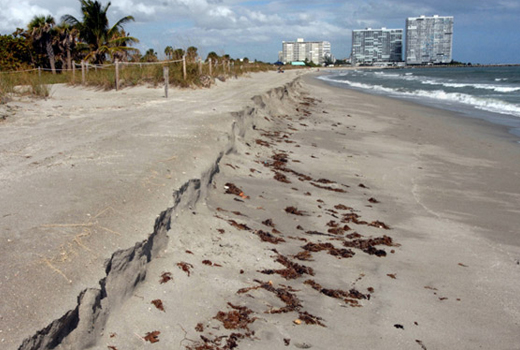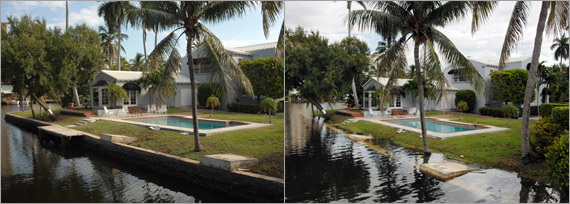Southeast Florida’s Regional Climate Change Compact
Southeast Florida is a region planning for the large scale, looming conditions of climate change, sea level rise and extreme weather event vulnerability. Hundreds of concerned parties are engaged in conversation intended to forge a pact under the auspices of the Southeast Florida Regional Climate Change Compact (SFRCCC). This collaboration is the start of regional coordination of resources and actions. For the past three years, Compact partner counties have held annual Climate Leadership Summits to advance policy and planning initiatives supporting shared mitigation and adaption strategies and goals. SFRCC was formalized in 2009 and represents “a joint commitment of Broward, Miami-Dade, Palm Beach and Monroe Counties.” Its genesis is in the federal advocacy efforts in which elective leadership from these four counties took part while Congress was considering significant energy legislation. Participating representatives from the counties were interested in seeing that legislation advance and were intent on having climate adaptation be part of the dialogue.
Prior to the Compact, individual counties had launched their own climate change task forces with significant resources assigned to those efforts. Broward and Miami-Dade Counties developed sea level rise projections, and these two plus Monroe County had completed some preliminary vulnerability mapping based on predicted increases in sea level with time. When elected leadership began to present visuals, and they were on the same page, messaging wasn’t adequately aligned as discrepancies existed between mapping techniques and sea level rise projections.
This initiated communication between the four counties, thus collectively garnering the kind of support, resources and attention needed for the region to be better aligned. Approximately 250 individuals attended the first Southeast Florida Regional Climate Leadership Summit in 2009, many of whom were elected officials from local, state and federal government, and regional agencies. The Summit’s panelists emphasized vulnerabilities created by the physical geography and topography of the land, which are coastal, flat and low-lying with dense urban development. Attendees recognized that the region shares these as well as airshed, watershed and traffic corridors.
A major deliverable from the first Summit was the unveiling of a climate compact, which elected officials from each of the four counties who served as leads at the summit agreed to take back to their respective governing bodies to seek formal adoption.
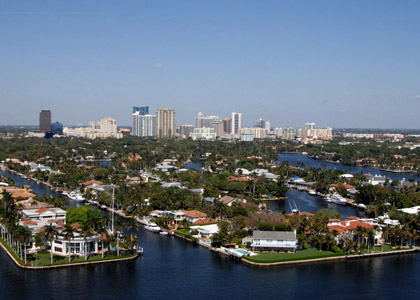
Photo by Paul Krashefski|Ft. Lauderdale Skyline
The Compact committed each of the counties to several strategic commitments. First is to partner in the development and advocacy of climate and energy policy at both state and federal levels. Second is to dedicate staff to a climate action team. Third is to charge staff and team with development of common baselines. These could be used for planning purposes, such as greenhouse gas emissions inventory and sea level rise projection vulnerability assessments and inundation mapping. This team would then work to develop regional mitigation and adaptation strategies. Finally, the Compact commits partners to reconvene annually to assess what needs to be done differently and what needs to be added or reprioritized.
The Compact was formally adopted by all four counties January 2010. During the first year the bulk of the effort was at staff level convening the right technical experts to help with baseline tools used by work groups focusing on topics of greenhouse gas emissions, sea level rise projections and vulnerability assessments. Organizationally, each of the counties dedicated two people to work on a steering committee, and the South Florida Water Management District (SFWMD) was invited to be a principal party in planning. The second annual Climate Leadership Summit brought in municipalities as key partners, thus appreciating that cities would ultimately implement many of the planning decisions, development considerations and infrastructure retrofits.
Time spent on emissions inventory helped prioritize reduction strategies. Through the vulnerability assessment work group, support was gained from the National Oceanic and Atmospheric Administration (NOAA), which helped with development of the regional digital elevation model. This is based on the most accurate and current LiDAR data that serves as a basis for vulnerability mapping. The combined forces of NOAA, SFWMD and the U.S Army Corps of Engineers (USACE) developed a strategy for expressing uncertainty, which included intervals and prioritization of infrastructure. All agreed upon USACE guidance data for sea level rise, which projects a 9 to 24-inch increase in sea level through the next 50 years or by 2060. Plans are to revisit the data in a few years when new projections are expected to be available.
USACE’s Glenn Landers comments, “I think the real future for work for the Corps involves climate adaptation, whether it’s sea level rise or changes in rain fall patterns and water supply impacts.” Landers was recently involved in a kick-off meeting for a five-year statewide conference and planning initiative aimed at community resiliency, which emphasized adaptation planning and hazard mitigation for coastal communities and related sea level rise. He continues, “When we’re looking at a trend of sea level rise likely to go on for multiple generations – potentially for multiple centuries – then we need to take a longer range view in our planning.”
Systems now in place to maintain flood protection and to prevent saltwater intrusion to drinking water, for aquifer wells in addition to the Everglades, are becoming less effective as sea level rises. Many South Florida canal systems rely on gravity drainage designed to be six to nine inches above high-tide. Since their design in the 1950s and 1960s, a nine-inch sea level rise within the last 100 years has used up much of that six inches and/or a portion of the nine inches. In Miami-Dade County some of the control structures are already recognized to have lost 80 percent of their capacity.
Regional recommendations for integrated water resources management are also beginning to be developed since climate change progression equates to longer and more extreme drought periods and more intense rains. A comprehensive and more holistic approach on how to use all water resources is being utilized, which includes not disposing of any water resources that could be considered a critical resource in the future. This encompasses managing stormwater for water supply and reclaiming wastewater for other water management objectives. It also includes managing rainfall runoff and other water resources in ways that help prevent saltwater intrusion of drinking water supplies.
Climate change also threatens ecologically and economically important natural systems. “Where pollutants may already be influencing the quality, abundance and diversity of our coastal resources, these pressures compromise the ability of our coral reefs and broader ecosystem to then adapt to additional physical changes in the environment. To the extent that we can improve our practices to lessen the current level of urban influence, we provide natural systems with a greater capacity for climate adaptation,” explains Jennifer Jurado, Ph.D. and director of Broward County’s Natural Resources Planning and Management Division.
As a region, approximately 50 percent of emissions come from residential and commercial sectors, and another almost 50 percent from transportation. Very little comes from true industry. To be successful in reaching regional greenhouse gas emissions reduction goals, coordinated work must be done to address existing building stock. A method is needed for achieving priority consideration of mass transit as part of future transportation projects. Development and redevelopment needs to advance the establishment of walkable communities and avoid causing pressures on natural systems. Designs need to be done in a way that is contemplative of changing physical conditions and that reduces long-term losses by constructing with appropriate standards for future conditions. Miami-Dade County already has a growth constraining urban boundary that has yet to reflect which areas are vulnerable or not.
Moving into 2011 with baseline deliverables developed, compact counties convened a broad team of approximately 140 diverse entities. Representatives included those from the professional fields of energy, economic development, insurance, hazard mitigation, emergency management, regional planning, water resources management from drainage districts and water utility directors, consulting engineering and environmental interests. Professionals participated in development of the regional action plan focusing on three areas: the built environment, transportation, and natural systems and land.
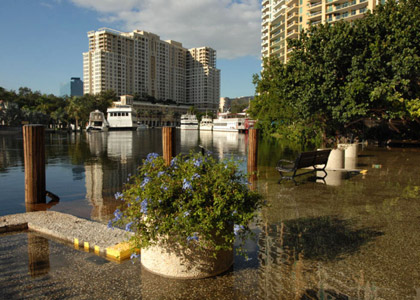
Photo by Paul Krashefski
Throughout the following year, work was done translating into 106 recommendations – issues that could either gain tremendous headway or could leave an effort without regional coordination at a disadvantage.
Recommendations were drafted into the Southeast Florida Regional Climate Action Plan released at the third annual Climate Leadership Summit held December 2011. With an economic development theme, this two-day event brought great numbers from the business community. Sustainability efforts, such as mitigation and adaptation planning, are being seen as opportunities rather than liabilities. Following its release, the action plan was publicly posted. Dozens of comments were received from entities inside and outside the region, and the Regional Action Plan is hoped to be finalized in the coming months.
The document is flexible in its use by each of the communities. “We think there’s going to be a lot of opportunity for each of the partner communities to set their priorities as they look at all the recommendations and think about where they’re most interested in investing resources up-front,” mentions Jurado. The six subject areas of the action plan include: sustainable communities and transportation planning, water supply management and infrastructure, natural systems and agriculture, energy and fuel, risk reduction and emergency management, and outreach and public policy. Landers notes, “There’s a funding issue if you procrastinate a long time, until there are great needs, and then everybody’s needs can’t be funded.”
The four counties as a region have made incredible headway in the area of policy. In the 2011 legislative session they partnered in pursuing an amendment to the growth management act. This allows local governments to make designations of adaptation action areas and areas of the community vulnerable to flooding associated with tidal inundation, high-tide events and sea level rise. This serves as a planning tool to prioritize necessary infrastructure improvements and retrofits, and to align funding with those areas.
The Compact has a future open to expansion. “We’re going to be working with the South Florida and Treasure Coast Regional Planning Councils as part of a seven county planning initiative to try to integrate this planning document into a broader sustainable communities’ initiative,” says Jurado. She adds, “We’ll be working on implementation and piloted implementation of some of these strategies in the next year with the expectation they could be used to advance planning initiatives of neighbor communities that may not have the same level of resources in place.” Those involved could help to accelerate the environmentally and socially responsible plans and actions occurring with the combined effort of the four counties that created the Southeast Florida Regional Climate Change Compact.
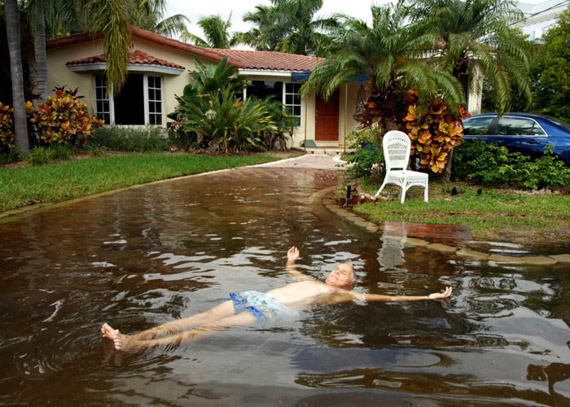
Photo by Paul Krashefski

